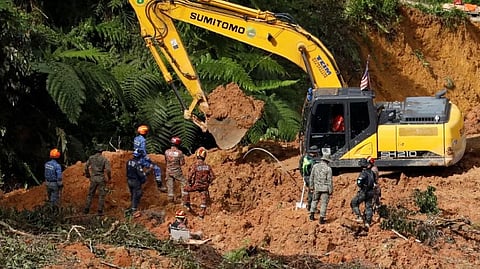

Earlier this month, the Hyderabad-based National Remote Sensing Centre of ISRO, released its Landslide Atlas report, which said two hill districts of Rudraprayag and Tehri in Uttarakhand have the maximum exposure risk to landslides in India. The district of Rudraprayag which is home to the Kedarnath shrine has as many as 32 chronic landslide zones, with most of them located on the NH-107, which leads to the temple town. Among 147 districts prone to landslides, the aforementioned two have been ranked first and second respectively. Also, the district Chamoli in Uttarakhand, where the land subsidence-hit Joshimath is located is ranked 19th on this list. It might be recalled that as many as 849 houses in Joshimath had developed cracks in January this year due to the incidence of land subsidence. The National Oceanic and Atmospheric Administration (NOAA) defines subsidence as the phenomenon of surface sinking resulting from subterranean material movement. It can take place due to a range of man-made or natural causes, including the exploitation of water, oil, or natural resources, apart from the undertaking of mining activities.
Other reasons behind it include earthquakes, soil degradation, and soil compaction. Scientists surmise that uncontrolled construction, population explosion, barricading the natural flow of water, and hydropower activities have all contributed to the situation in Joshimath. Residents have now demanded the closure of projects initiated by the National Thermal Power Corporation (NTPC) in the area, which they believed caused the land subsidence episode.
According to environmental activists, apart from geological factors, the failure of successive governments to act upon the warnings issued by experts regarding the possible hazards in Joshimath and the adjoining areas is one of the main reasons for the land subsidence crisis here. In fact, land subsidence episodes in mountainous urban India have become increasingly prevalent, and it is estimated that about 12.6% of the country’s land area is prone to landslides. This is especially true in the cases of Sikkim, West Bengal and Uttarakhand. The National Institute of Disaster Management has placed the onus of such incidents on urban policy.
The National Landslide Risk Management Strategy (Sept 2019) highlights that construction in such regions is carried out on that back of building bye-laws that do not take into cognizance local geological factors. As a result, land use planning in the Western Ghats as well as Himalayan towns is more often than not ill-conceived. This adds to the problem of slope instability, which in turn leads to a rise in landslide vulnerability. The problems are compounded by tunnelling constructions, which cause rock formations to weaken.
As per experts, collecting credible data is a start point towards enhancing the resilience of urban regions with regard to land subsidence. There is a need for mapping landslide risks on a granular level. Stakeholders believe that in areas with a major risk for landslides, expansion of infrastructure projects should not be undertaken. There should also be efforts to reduce human intervention in such zones and adhere to the rules of carrying capacity.
What is needed in case of site developments in hazardous regions is a thorough assessment by geologists, who can evaluate the land for soil suitability, slope stability, and impact on nearby buildings. Going forward, civic authorities must factor in the impact of climate change and extreme weather when charting out urban master plans. Every city will need a disaster management framework in place, which includes early warning systems, rescue, evacuation and rehabilitation protocols that are clearly defined.
Visit news.dtnext.in to explore our interactive epaper!
Download the DT Next app for more exciting features!
Click here for iOS
Click here for Android